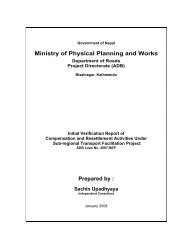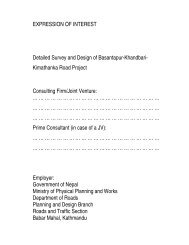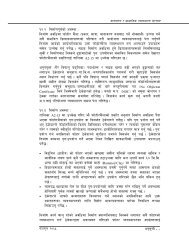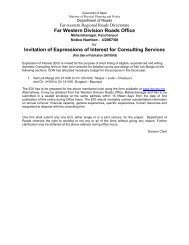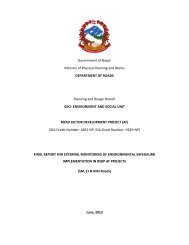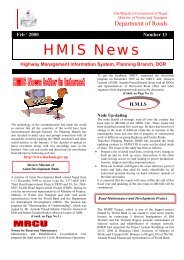Environmental & Social Management Framework - About ...
Environmental & Social Management Framework - About ...
Environmental & Social Management Framework - About ...
Create successful ePaper yourself
Turn your PDF publications into a flip-book with our unique Google optimized e-Paper software.
<strong>Environmental</strong> and <strong>Social</strong> <strong>Management</strong> <strong>Framework</strong>On the basis of these consultations and field surveys, it appears that the SRNprojects will have no major environmental and social impacts, for the followingreasons:Almost all sub-projects (with the exception of the 87 km Nagma-Gamghadi Roadin Mugu District, consist of upgrading or improving existing roads. Therefore,minimal adverse impacts are to be expected, such as loss of land, damage tolocal infrastructure, loss of vegetation, and slope cutting, that are related toopening up of new tracks. With prudent management options incorporated in theplanning it is believed that most of these impacts can adequately be mitigated.The ESMF makes provision that all roads considered under this program willhave an <strong>Environmental</strong> <strong>Management</strong> Plan and an <strong>Social</strong> <strong>Management</strong> Plan,including, as required, an Resettlement Action Plan. It is intended to involve tothe extent possible the local communities, especially the underprivileged strata, inroad construction as well as monitoring activities.Hill roads often suffer from problems related to slope failure and erosion. TheSRN project will improve existing areas with unstable slopes, using protectionstructures and bio-engineering and it will use labour-based technology which willminimize damage to fragile slopes.In the Terai, almost all the proposed roads are north-south roads. The potentialfor flood damage is less in these roads than east-west roads. Furthermore, assome of the north-south roads also function as embankments, the roads willassist in flood control.4.3 Adverse ImpactsThere appears a broad consensus among the local people consulted during theongoing surveys for the SRN Program that there will be very little, if any, adverseenvironmental and social impacts and many expect the project to improveenvironmental conditions caused by existing roads. These mainly include poordrainage conditions in the Terai and unstable slopes in some areas in the hills,and subsequently some adverse effects on local forest and agricultural lands.Few people fear that the newly rehabilitated or constructed roads will result indamages on wildlife and aquatic resources.Depending on the environmental setting, some construction practices are moresensitive in terms of environmental hazards than others. For example, inmountain terrain gradual widening, of a narrow track of typically 2 m width bearsmuch more risks than doing the same in flat terrain. In the first case intensiveslope stabilisation measures or blasting might be required, all of which mayinclude significant residual risks of failure and cumulative impacts. In contrast, thesecond setting may require much more consideration of preventing losses offarmlands and suitable sites for habitation. Similarly, the use of labour and handtools instead of heavy machinery will result in completely different environmentalimpacts in certain conditions. Conservation/protection of soils, water resources,fauna and flora need equally be seen in the local context, including other externalimpacts like rainfall, seismicity, over-use of certain natural resources, law / ordersituation etc.The following sub-section gives an overview of potential adverse environmentaland social impacts that are likely to occur during the different stages of the roadprojects proposed under the SRN Program.Chapter 4-6 April 2007



![j:6 ]zg cfof ]hgf](https://img.yumpu.com/51286794/1/190x245/j6-zg-cfof-hgf.jpg?quality=85)

![x'nfsL /fhdfu { cfof ]hgf](https://img.yumpu.com/50581959/1/190x245/xnfsl-fhdfu-cfof-hgf.jpg?quality=85)
